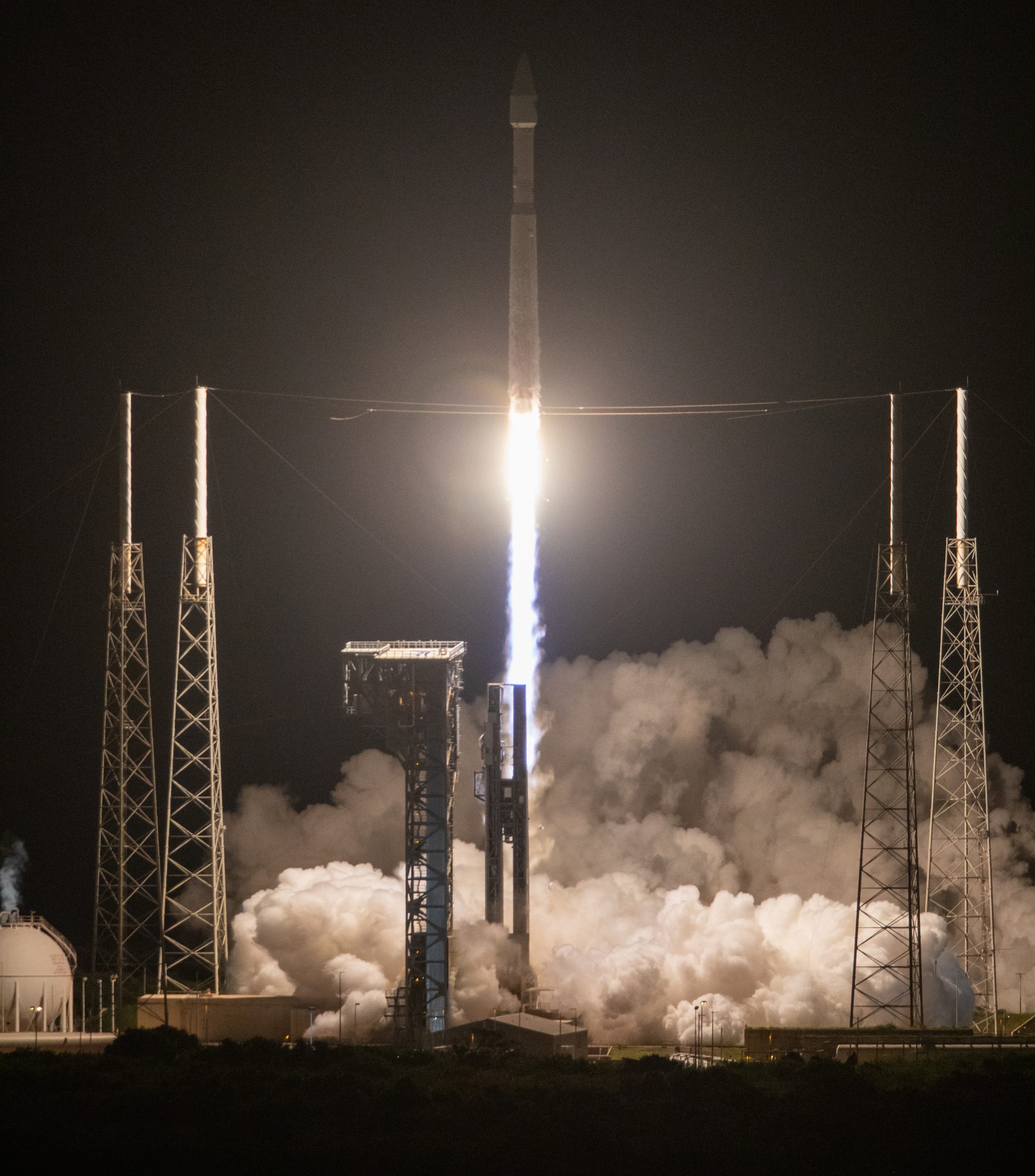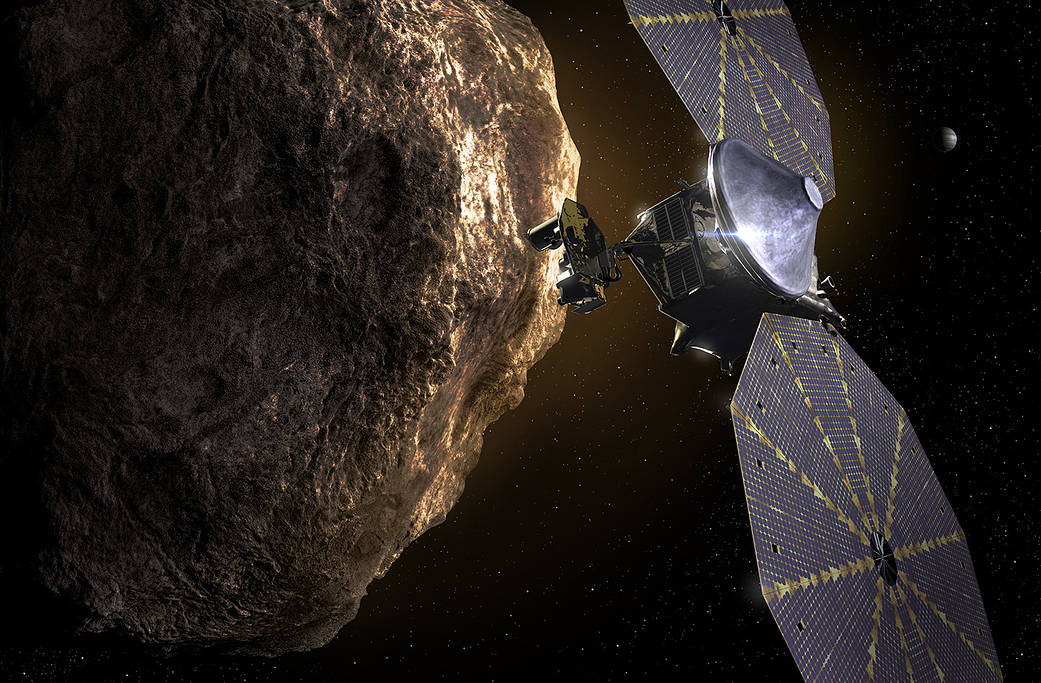The Lucy spacecraft remains in cruise mode, which is the standard flight mode for outbound flight and allows for substantial autonomy for the spacecraft. The spacecraft has successfully executed several small planned maneuvers, which have had no adverse effect on the one solar array that is not fully deployed. On Oct. 29, NASA will adjust Lucy’s position to point toward Earth in preparation for instrument checkout.
Most recently, the spacecraft’s position was adjusted on Oct. 26 to allow the team to measure how much electric current is moving through the partially deployed solar array and thus understand how close that array is to the fully latched position. Analysis indicates that the array is between 75% and 95% deployed. It is currently being held in place by a lanyard, specifically designed to help unfurl the arrays during deployment.
An anomaly response team continues to work on establishing what caused the solar array to not fully deploy. NASA and SwRI are evaluating a range of options, including the possibility of leaving the array in its current state. Any attempt to safely redeploy the array would occur no earlier than Nov. 16.
All other systems are functioning normally.
Month: October 2021
Lucy Spacecraft Healthy as NASA Continues Solar Array Assessments
NASA’s Lucy spacecraft successfully transitioned to cruise mode Oct. 20, which is the standard configuration for flight. The following day, the instrument pointing platform was deployed after temporarily being postponed earlier in the week. Both events were normal and raised no concerns. The spacecraft remains stable, power positive, with all other subsystems working, with the exception of one solar array.
The Lucy team is working to understand the current state of the array before attempting to complete deployment. NASA is reviewing spacecraft data, including using techniques to measure how much electric current is produced by the array during various spacecraft positions and attitudes. This will allow the team to understand how close the array is to the latched position. These techniques are well within the capabilities of the system and pose no risk. Any plans for re-deployment will be considered after completing this latest assessment.
The spacecraft continues to travel along its expected trajectory –track its path online.
NASA Team Remains Focused on Lucy’s Solar Arrays
After successful separation from the rocket on Oct. 16, NASA’s Lucy spacecraft deployed both solar arrays. Soon after deployment, NASA received confirmation that one of the solar arrays was fully deployed and latched. Analysis currently shows the second solar array is partially unfurled. The team continues to look at all available engineering data to establish how far it is deployed. That solar array is generating nearly the expected power when compared to the fully deployed wing. This power level is enough to keep the spacecraft healthy and functioning.
The Lucy spacecraft has remained in safe mode and is transitioning to cruise mode today. This mode has increased autonomy and spacecraft configuration changes, which is necessary as Lucy moves away from Earth. The team continues its assessment and an attempt to fully deploy the solar array is planned no earlier than the end of next week.
Lucy has successfully fired thrusters to slew the spacecraft with the current array configuration and will safely continue with desaturation maneuvers — small thruster firings to manage the spacecraft’s momentum — as planned.
The operations team has temporarily postponed the deployment of the instrument pointing platform to focus on resolving solar array deployment. The operations team continues to execute all other planned post-launch activities. The ULA Atlas V rocket delivered Lucy precisely to the target point at separation, and so a backup maneuver called the Trajectory Correction Maneuver (TCM-1) is unnecessary and has therefore been canceled. The first maneuver will now be what’s known as TCM-2, currently scheduled for mid-December.
The project is evaluating whether there are any long-term implications to other scheduled activities.
Lucy Spacecraft Healthy; Solar Arrays Being Analyzed
Following a successful launch on Oct. 16, 2021, analysis of NASA’s Lucy spacecraft systems show the spacecraft is operating well and is stable. Lucy’s two solar arrays have deployed, and both are producing power and the battery is charging. While one of the arrays has latched, indications are that the second array may not be fully latched. All other subsystems are normal. In the current spacecraft attitude, Lucy can continue to operate with no threat to its health and safety. The team is analyzing spacecraft data to understand the situation and determine next steps to achieve full deployment of the solar array.
NASA, ULA Launch Lucy Mission to ‘Fossils’ of Planet Formation

NASA’s Lucy mission, the agency’s first to Jupiter’s Trojan asteroids, launched at 5:34 a.m. EDT Saturday on a United Launch Alliance (ULA) Atlas V rocket from Space Launch Complex 41 at Cape Canaveral Space Force Station in Florida.
Over the next 12 years, Lucy will fly by one main-belt asteroid and seven Trojan asteroids, making it the agency’s first single spacecraft mission in history to explore so many different asteroids. Lucy will investigate these “fossils” of planetary formation up close during its journey.
“Lucy embodies NASA’s enduring quest to push out into the cosmos for the sake of exploration and science, to better understand the universe and our place within it,” said NASA Administrator Bill Nelson. “I can’t wait to see what mysteries the mission uncovers!”
About an hour after launch, Lucy separated from the second stage of the ULA Atlas V 401 rocket. Its two massive solar arrays, each nearly 24 feet (7.3 meters) wide, successfully unfurled about 30 minutes later and began charging the spacecraft’s batteries to power its subsystems.
“Today’s launch marks a genuine full-circle moment for me as Lucy was the first mission I approved in 2017, just a few months after joining NASA,” said Thomas Zurbuchen, associate administrator for NASA’s Science Mission Directorate at the agency’s Headquarters in Washington. “A true mission of discovery, Lucy is rich with opportunity to learn more about these mysterious Trojan asteroids and better understand the formation and evolution of the early solar system.”
Lucy sent its first signal to Earth from its own antenna to NASA’s Deep Space Network at 6:40 a.m. EDT. The spacecraft is now traveling at roughly 67,000 mph (108,000 kph) on a trajectory that will orbit the Sun and bring it back toward Earth in October 2022 for a gravity assist.
Named for the fossilized skeleton of one of our earliest known hominin ancestors, the Lucy mission will allow scientists to explore two swarms of Trojan asteroids that share an orbit around the Sun with Jupiter. Scientific evidence indicates that Trojan asteroids are remnants of the material that formed giant planets. Studying them can reveal previously unknown information about their formation and our solar system’s evolution in the same way the fossilized skeleton of Lucy revolutionized our understanding of human evolution.
“We started working on the Lucy mission concept early in 2014, so this launch has been long in the making,” said Hal Levison, Lucy principal investigator, based out of the Boulder, Colorado, branch of Southwest Research Institute (SwRI), which is headquartered in San Antonio. “It will still be several years before we get to the first Trojan asteroid, but these objects are worth the wait and all the effort because of their immense scientific value. They are like diamonds in the sky.”
Lucy’s Trojan destinations are trapped near Jupiter’s Lagrange points – gravitationally stable locations in space associated with a planet’s orbit where smaller masses can be trapped. One swarm of Trojans is ahead of the gas giant planet, and another is behind it. The asteroids in Jupiter’s Trojan swarms are as far away from Jupiter as they are from the Sun.
The spacecraft’s first Earth gravity assist in 2022 will accelerate and direct Lucy’s trajectory beyond the orbit of Mars. The spacecraft will then swing back toward Earth for another gravity assist in 2024, which will propel Lucy toward the Donaldjohanson asteroid – located within the solar system’s main asteroid belt – in 2025.
Lucy will then journey toward its first Trojan asteroid encounter in the swarm ahead of Jupiter for a 2027 arrival. After completing its first four targeted flybys, the spacecraft will travel back to Earth for a third gravity boost in 2031, which will catapult it to the trailing swarm of Trojans for a 2033 encounter.
“Today we celebrate this incredible milestone and look forward to the new discoveries that Lucy will uncover,” said Donya Douglas-Bradshaw, Lucy project manager at NASA’s Goddard Space Flight Center in Greenbelt, Maryland.
NASA Goddard provides overall mission management, systems engineering, plus safety and mission assurance. Lockheed Martin Space in Littleton, Colorado, built the spacecraft. Lucy is the 13th mission in NASA’s Discovery Program. NASA’s Marshall Space Flight Center in Huntsville, Alabama, manages the Discovery Program for the agency.
For more information about NASA’s Lucy mission, visit: https://www.nasa.gov/mission_pages/lucy/overview/index.
This concludes today’s coverage on the blog of the Lucy countdown, launch and ascent into space.
Exploring the Trojan Asteroids

During its 12-year mission, NASA’s Lucy spacecraft will explore eight asteroids. It will explore more asteroids than any previous mission. On its way out to the Trojan asteroids, Lucy will fly by the main belt asteroid (52246) Donaldjohanson on April 20, 2025. There, Lucy will fly by five of these L4 Trojans: Eurybates and its satellite, Queta, on Aug. 27, 2027, Polymele on Sept. 15, 2027, Leucus on April 18, 2028, and Orus on Nov. 11, 2028.
The spacecraft’s orbit will then bring Lucy back to the vicinity of the Earth for another gravity assist, and will take it again out to the distance of Jupiter. Arriving on March 2, 2033, Lucy will fly by Patroclus and its near-twin binary companion Menoetius. While the flyby of this remarkable asteroid pair will be the expected finale of the mission. Lucy will remain on a stable orbit which will enable it to visit the Trojan swarms over and over again for many thousands, and possibly millions, of years.
Lucy’s Solar Arrays Deployed
Lucy’s twin solar arrays have deployed. Acquisition of the signal has been confirmed and health of the spacecraft is being checked. Lucy is now operating on its own power and begins its journey to reach the Trojan asteroids.
Lucy Separates from the Centaur Upper Stage
We have spacecraft separation! Cheers and applause can be heard from the launch teams as the Lucy spacecraft separates from the United Launch Alliance Atlas V Centaur upper stage to fly freely for the first time. In just a few minutes, the spacecraft’s solar arrays will deploy.
Second Centaur Engine Burn Ends
The second engine burn of the Centaur has ended. Next up will be separation of the Lucy spacecraft from Centaur.
Second Centaur Engine Burn Starts
The second engine burn of the Centaur upper stage has begun and will last for about six minutes.
